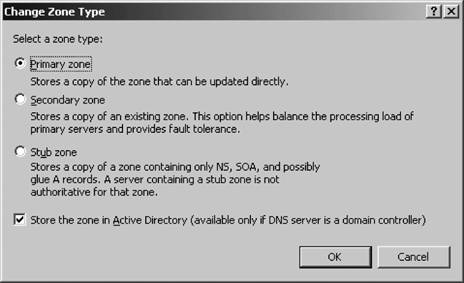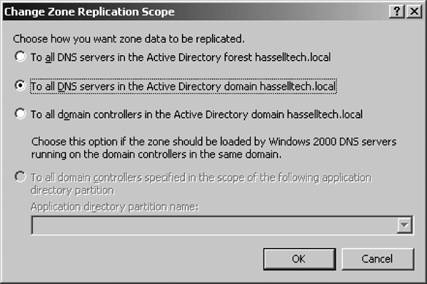Section 4.8. Active Directory-Integrated Zones
4.8. Active Directory-Integrated ZonesUp to this point, I've treated the Windows Server 2003 DNS service as a traditional nameserver, mostly compliant with the relevant RFCs, which can act in both primary and secondary "modes" for a zone. However, Windows Server 2003 offers a third mode specific to Windows that, although not listed in an RFC, offers some distinct advantages if you've made an infrastructure investment in Active Directory and Windows. The third mode, Active Directory-integrated DNS , offers two plusses over traditional zones. For one, the fault tolerance built into Active Directory eliminates the need for primary and secondary nameservers. Effectively, all nameservers using Active Directory-integrated zones are primary nameservers. This has a huge advantage for the use of dynamic DNS as well: namely, the wide availability of nameservers that can accept registrations. Recall that domain controllers and workstations register their locations and availability to the DNS zone using dynamic DNS. In a traditional DNS setup, only one type of nameserver can accept these registrationsthe primary server, because it has the only read/write copy of a zone. By creating an Active Directory-integrated zone, all Windows Server 2003 nameservers that store their zone data in Active Directory can accept a dynamic registration, and the change will be propagated using Active Directory multi-master replication, something you'll learn about in Chapter 5. All you need to do to set up this scenario is install Windows Server 2003 on a machine, configure it as a domain controller, install the DNS service, and set up the zone. It's all automatic after that. Contrast this with the standard primary-secondary nameserver setup, where the primary server is likely to be very busy handling requests and zone transfers without worrying about the added load of dynamic DNS registrations. Active Directory-integrated zones relieve this load considerably. And to add to the benefits, Active Directory-integrated zones support compression of replication traffic between sites, which also makes it unnecessary to use the old-style "uncompressed" zone transfers.
Active Directory-integrated zones also afford a big security advantage, in that they provide the capability to lock down dynamic DNS functionality by restricting the ability of users and computers to register records into the systemonly computers that are members of the Active Directory domain that hosts the DNS records can add and update records dynamically to these zones. However, to have an Active Directory-integrated zone, your nameservers must be domain controllers for an Active Directory domain. If other nameservers are used that are not domain controllers, they can act as only traditional secondary nameservers, holding a read-only copy of the zone and replicating via the traditional zone transfer process. If you're already running a nameserver that is a domain controller with an active zone in service, it's easy to convert that to an Active Directory-integrated zone. (And for that matter, it's easy to revert to a primary or secondary zonethis isn't a be-all and end-all.) Here's how to go forward:
Figure 4-21. Storing a zone in Active Directory You'll note that your options expand once you've converted to Active Directory-integrated zones. Go back to the zone's properties, and on the General tab, note a couple of things:
Let's focus on the latter for a moment. 4.8.1. Replication Among Domain ControllersWindows Server 2003 introduces a new feature that allows you to tune how Active Directory replicates DNS information to other domain controllers. (While I'll present AD in all of its glory in Chapter 5, I'll go ahead and cover this here.) Click the Change button beside the Replication field on the zone properties, and you'll be presented with the Change Zone Replication Scope screen as shown in Figure 4-22. The default setting is "To all domain controllers in the Active Directory domain," which instructs Windows to behave exactly as it did in Windows 2000 Server: replicate DNS information to all domain controllers in Active Directory, regardless of whether they're actually running the DNS service. Obviously, if you have 20 domain controllers in your domain, but only three domain controllers that run DNS, this is a lot of replication traffic that is just wasted. On this screen, you can select to replicate the DNS information only to domain controllers running DNS in either the forest or the domain. This is very helpful, and for large organizations, it should cut down on WAN traffic. Figure 4-22. Controlling DNS replication in Active Directory |
EAN: 2147483647
Pages: 171

